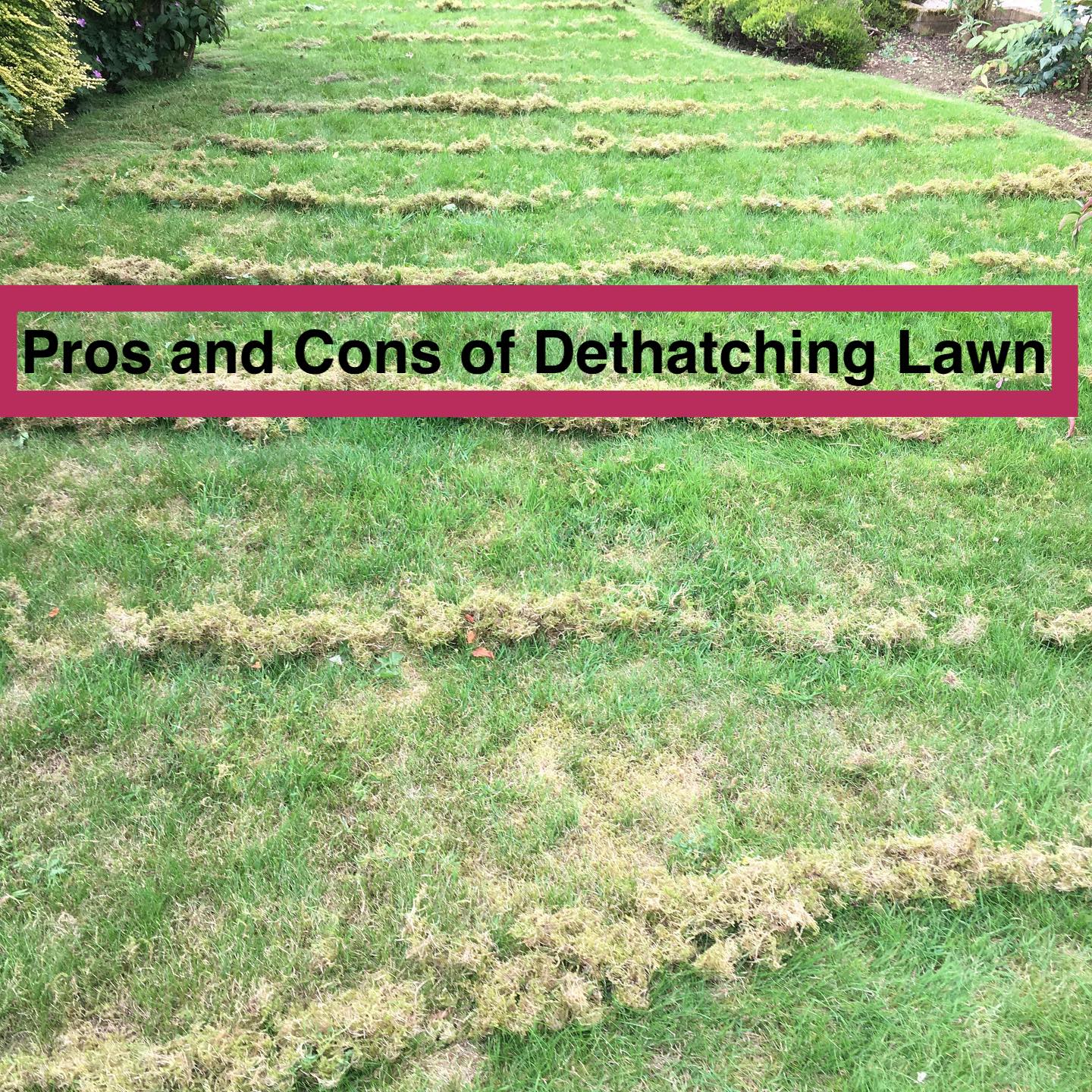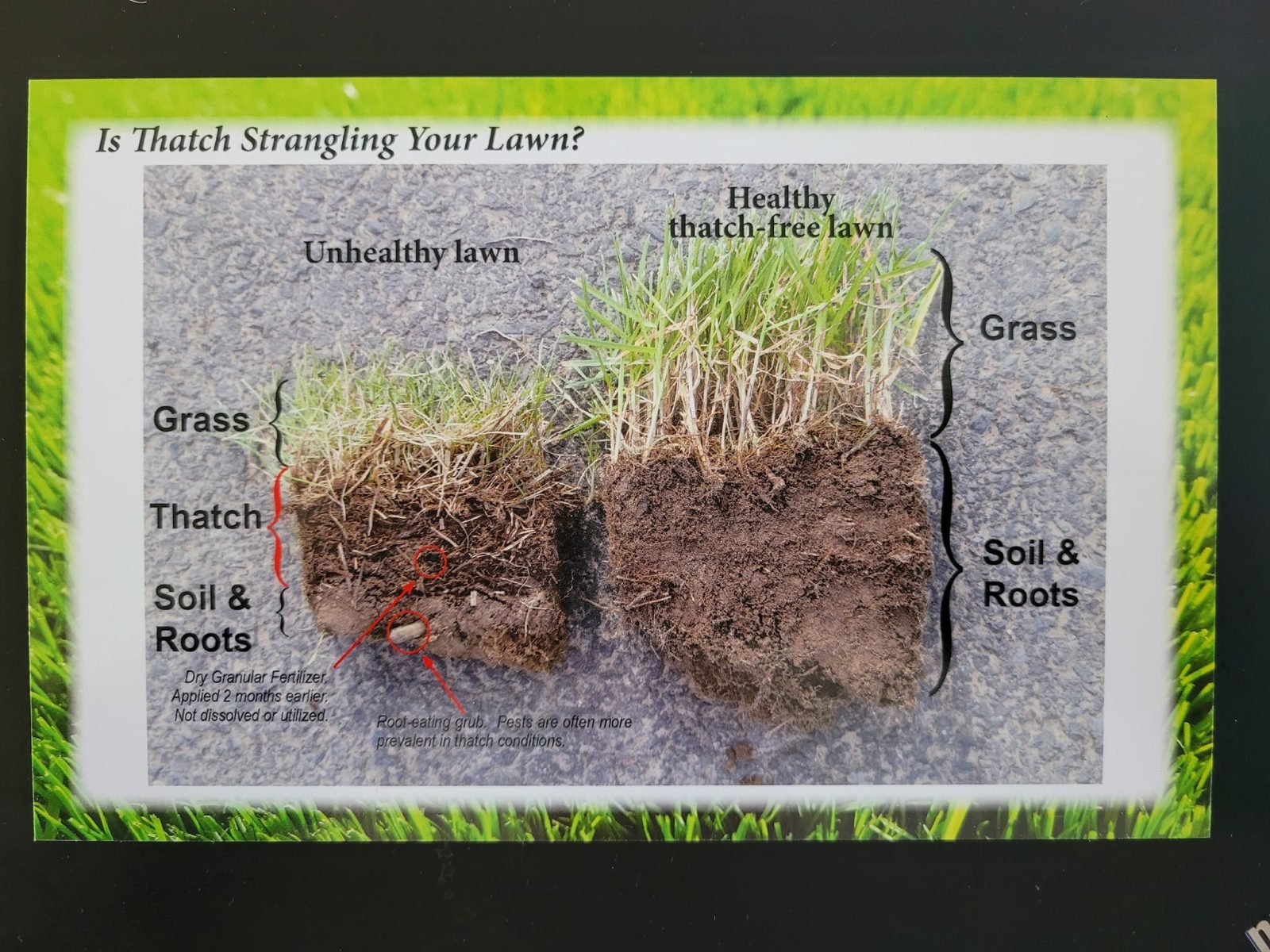Considering the damage dethatching can cause to your grass, you probably wonder why this practice is done entirely.
The truth is there are pros and cons of dethatching lawn and knowing both sides of the coin will help you gain more information on thatch, setting you up for success.

The choices you make regarding your lawn care can either help you grow healthy grass or have a struggling lawn.
While thatch is beneficial to your yard, too much of it can be detrimental to the growth and health of your grass, and that’s where dethatching comes in.
Also Read:
This post defines thatch and dethatching and discusses the pros and cons of dethatching lawns. So, keep reading to discover more about lawn dethatching.
What Is Thatch?
Thatch refers to the buildup of dead and living organic matter layers between the surface of the soil and the vegetation zone.
It is made up of weeds, dead grass, leaves, rhizomes, grass stems, crowns, and roots. Since grass clippings disintegrate quickly, they do not contribute to thatch formation.
Thatch buildup occurs gradually, and all lawns typically have a bit of thatch unless you rake yours regularly to get rid of it.
The rate of thatch buildup varies based on the grass type. Warm grasses like Buffalo, Bermuda, and Zoysia generate thatch faster.
On the other hand, the production rate in cool-season grasses like Ryegrass, Fescue, and Bluegrass is much slower.
Having some thatch in your lawn is advisable because it minimizes water loss, insulates grass crowns, makes your lawn more tolerant to foot traffic, and keeps the ground cool.
However, too much thatch is problematic, so while you should have some thatch in your lawn, ensure the build is not over ½-inch thick.
What is Dethatching?
Dethatching is the process of getting rid of excess thatch from your lawn using a power rake, vertical mower, or a dethatching rake.
While most homeowners use dethatching as a last resort when dealing with too much thatch buildup, the approach helps the grass grow.
Dethatching damages grass, so it must be conducted strategically, usually in early summer or late spring, for warm-season grasses after they begin growing.
Early fall is the best time to dethatch cool-season grasses since the grass grows swiftly during this period.
Dethatch only when the thatch buildup is thicker than 0.5 inches. To measure the thatch thickness, stick your finger or a piece of stick into your lawn through the thatch (brown layer) until you get to the topsoil.
Pros of Dethatching Lawn
Dethatching a lawn offers a plethora of benefits.
Here are the reasons to dethatch your yard.
1. It boosts the penetration of nutrients, sunlight, water and air into the roots
Your grass requires the above resources to grow and stay healthy. However, excessively thick thatch soaks up water, thus acting like a sponge, keeping air and water from getting into the roots.
A lawn with too much thatch will also struggle to absorb the essential nutrients (phosphorus, nitrogen, and potassium) and sunlight.
Therefore, reducing the thatch buildup by dethatching allows these resources to get to the roots.
2. Increases herbicide and fertilizer penetration
Removing the barrier created by thatch ensures the fertilizers and herbicides you apply to your lawn penetrate the soil and are absorbed by the roots.
3. Improves lawn drainage
A thick thatch layer will impair your lawn’s drainage capabilities, causing water to drain extremely slowly or not at all.
Having rainwater still stagnant on your lawn days after a heavy downpour is bad for the grass because it encourages lawn diseases and pests.
It also offers a breeding ground for disease-causing vectors like malaria. You can avoid these issues by improving your lawn drainage through dethatching.
4. Reduces the lawn’s vulnerability to diseases
Some disease-causing organisms thrive in warm and moist conditions, like mites and booklice, while others love areas with deficient free oxygen and thick thatch facilitate these conditions.
Therefore, dethatching discourages the survival of fungal organisms like Sclerotinia homoeocarpa that thrive in areas without enough oxygen and cause Dollar Spot.
5. Aids the success of overseeding
Thatch creates a pseudo substrate layer when it mixes with topsoil. If you overseed your lawn while thatch is still there, the new grass will germinate in the layer of thatch, and since thatch does not hold nutrients properly, this grass will not be very healthy and can die quickly. Therefore, promote a successful overseeding by dethatching before overseeding.
Note
Dethatching also helps remove dead grass, allowing the healthy ones to thrive and beautify your lawn.
Cons of Dethatching Your Lawn
Below are the cons of dethatching your lawn.
1) Stresses the lawn
A dethatched lawn undergoes stress and will need time to recover; that is why you should do it when it is actively growing. Your lawn will not look bad after dethatching, but it will recover in due time. In addition, dethatching your lawn incorrectly with aggressive tools causes excess injury to the turf.
2) Encourages the growth of weeds
Since dethatching facilitates proper penetration of water, nutrients, oxygen, and sunlight, it helps weeds sprout up. The unwanted plants absorb the resources meant for your grass, compromising their health and increasing your yard work since you must act swiftly to eliminate them.
3) Dries out the lawn soil
Since thatch limits the penetration of atmospheric heat and sunlight into the soil, slowing down evaporation and improving moisture retention, dethatching has the opposite effect. The lawn soil will preserve less moisture because of increased heat and sun penetration.
This means you will need to water your lawn more to keep the ground moist and the grass green and lush.
Also read: How to get a lush green lawn
What Causes Excess Thatch in Lawns?
Some factors promote the buildup of excess thatch. These are:
1. The grass type
Thatch accumulates faster in some grasses because they generate more stem tissue compared to others. These include cool-season grasses like creeping bentgrass, creeping red fescue, and Kentucky bluegrass. On the flip side, tall fescue and perennial ryegrass do not typically have excess thatch.
2. Aggressive fertilization
If you apply too much nitrogen to your lawn, too much production can occur in the grass leaves and stems, leading to more thatch buildup, even on grasses that usually don’t have thatch accumulation issues.
3. Minimal microbe activity
Thatch accumulates if organic material (dead material) production exceeds the microorganisms’ ability to disintegrate organic matter. Also, sandy, clay, cold, or compacted soils can lack sufficient microorganisms to control thatch buildup.
4. Poor lawn care practices
Increased thatch buildup can also be caused by using synthetic fertilizers and chemical pesticides and improper watering practices- irrigating too frequently or overwatering your lawn.
How Do You Stop Thatch Buildup?
Instead of raking or dethatching your lawn frequently, reduce thatch building by adopting a great management program and cultural practices.
a) Regular soil tests
Frequently testing your lawn soil will help you catch any changes in the soil PH that could lead to a drop in microbial activity.
b) Core aeration
You can also raise microorganisms’ activity and lessen soil compaction through core aeration.
c) Applying pesticides and fertilizers responsibly
Using controlled amounts of pesticides and fertilizers will help boost the rate at which organic matter breaks down. Avoiding excess fertilizers also prevents rapid grass growth.
d) Watering the lawn correctly
Irrigating your lawn infrequently and deeply encourages the roots to grow deeper into the soil rather than the thatch layer.
Frequently Asked Questions
How long does it take a lawn to recover after dethatching?
A lawn takes about 3 to 4 weeks to recover from dethatching and develop new growth.
Do I Need to Reseed After Dethatching?
You should reseed your lawn after dethatching because it will help replace the section of grass you removed while dethatching and fill other patches.
This will ensure you have a beautiful, thick lawn the following season. You can overseed even if your lawn looks green and healthy, as that will only make your yard lusher.
Make sure you buy the right grass seeds; knowing the type of grass in your lawn will help you make the correct choice.
Is dethatching better than aerating?
Dethatching and aerating serve the same purpose in lawn maintenance, but aeration achieves the results without hurting the lawn; that’s why many prefer it. Nonetheless, these practices are both beneficial.
For instance, dethatching mainly loosens the topsoil, removes dead grass, and promotes fruitful overseeding by ensuring the new grass germinates in the topsoil, not the thatch layer. On the other hand, core aeration removes thatch buildup and reduces soil compaction.
Final Remarks
Dethatching your lawn can be both beneficial and detrimental depending on your specific situation. While removing excessive thatch can promote healthy grass growth and reduce the risk of pests and diseases, too much dethatching can damage your lawn and disrupt the soil ecosystem.
Before deciding to dethatch your lawn, it’s important to consider the type of grass you have, the thickness of the thatch, and the overall health of your lawn. If you do decide to dethatch, be sure to use the right tools and techniques to avoid causing further damage.
Ultimately, the decision to dethatch your lawn should be based on careful consideration and assessment of the specific needs of your lawn. With proper care and maintenance, you can keep your lawn healthy and thriving for years to come.

Hey there, I’m Derek Schew, a writer for Lawnholic.com, where we cover everything and anything related to lawns. As someone who’s spent countless hours tending to my own lawn, I’m passionate about sharing my knowledge and helping others achieve the perfect yard. From lawn care tips to product reviews, I’m committed to providing our readers with the most accurate and up-to-date information available. So whether you’re a seasoned lawn enthusiast or just getting started, I invite you to join our community and discover the joys of a lush, green lawn.

